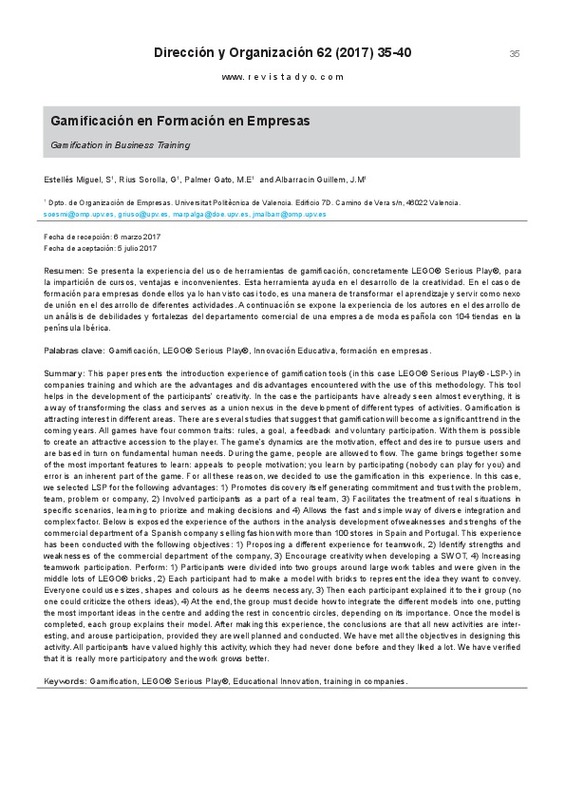JavaScript is disabled for your browser. Some features of this site may not work without it.
Buscar en RiuNet
Listar
Mi cuenta
Estadísticas
Ayuda RiuNet
Admin. UPV
Gamificación en Formación en Empresas
Mostrar el registro sencillo del ítem
Ficheros en el ítem
| dc.contributor.author | Estelles Miguel, Sofia
|
es_ES |
| dc.contributor.author | Rius Sorolla, Gregorio
|
es_ES |
| dc.contributor.author | Palmer Gato, Marta Elena
|
es_ES |
| dc.contributor.author | Albarracín Guillem, José Miguel
|
es_ES |
| dc.date.accessioned | 2018-10-25T04:34:20Z | |
| dc.date.available | 2018-10-25T04:34:20Z | |
| dc.date.issued | 2017 | es_ES |
| dc.identifier.uri | http://hdl.handle.net/10251/111251 | |
| dc.description.abstract | [EN] This paper presents the introduction experience of gamification tools (in this case LEGO® Serious Play® -LSP-) in companies training and which are the advantages and disadvantages encountered with the use of this methodology. This tool helps in the development of the articipants¿ creativity. In the case the participants have already seen almost everything, it is a way of transforming the class and serves as a union nexus in the development of different types of activities. Gamification is attracting interest in different areas. There are several studies that suggest that gamification will become a significant trend in the coming years. All games have four common traits: rules, a goal, a feedback and voluntary participation. With them is possible to create an attractive accession to the player. The game¿s dynamics are the motivation, effect and desire to pursue users and are based in turn on fundamental human needs. During the game, people are allowed to flow. The game brings together some of the most important features to learn: appeals to people motivation; you learn by participating (nobody can play for you) and error is an inherent part of the game. For all these reason, we decided to use the gamification in this experience. In this case, we selected LSP for the following advantages: 1) Promotes discovery itself generating commitment and trust with the problem, team, problem or company, 2) Involved participants as a part of a real team, 3) Facilitates the treatment of real situations in specific scenarios, learning to priorize and making decisions and 4) Allows the fast and simple way of diverse integration and complex factor. Below is exposed the experience of the authors in the analysis development of weaknesses and strenghs of the commercial department of a Spanish company selling fashion with more than 100 stores in Spain and Portugal. This experience has been conducted with the following objectives: 1) Proposing a different experience for teamwork, 2) Identify strengths and weaknesses of the commercial department of the company, 3) Encourage creativity when developing a SWOT, 4) Increasing teamwork participation. Perform: 1) Participants were divided into two groups around large work tables and were given in the middle lots of LEGO® bricks, 2) Each participant had to make a model with bricks to represent the idea they want to convey. Everyone could use sizes, shapes and colours as he deems necessary, 3) Then each participant explained it to their group (no one could criticize the others ideas), 4) At the end, the group must decide how to integrate the different models into one, putting the most important ideas in the centre and adding the rest in concentric circles, depending on its importance. Once the model is completed, each group explains their model. After making this experience, the conclusions are that all new activities are interesting, and arouse participation, provided they are well planned and conducted. We have met all the objectives in designing this activity. All participants have valued highly this activity, which they had never done before and they liked a lot. We have verified that it is really more participatory and the work grows better. | es_ES |
| dc.description.abstract | [ES] Se presenta la experiencia del uso de herramientas de gamificación, concretamente LEGO® Serious Play®, para la impartición de cursos, ventajas e inconvenientes. Esta herramienta ayuda en el desarrollo de la creatividad. En el caso de formación para empresas donde ellos ya lo han visto casi todo, es una manera de transformar el aprendizaje y servir como nexo de unión en el desarrollo de diferentes actividades. A continuación se expone la experiencia de los autores en el desarrollo de un análisis de debilidades y fortalezas del departamento comercial de una empresa de moda española con 104 tiendas en la península Ibérica. | es_ES |
| dc.language | Español | es_ES |
| dc.publisher | Universidad Politécnica de Madrid. Centro de Estudios de Planificación y Administración de Empresas | es_ES |
| dc.relation.ispartof | Dirección y organización (Online) | es_ES |
| dc.rights | Reserva de todos los derechos | es_ES |
| dc.subject | Gamificación | es_ES |
| dc.subject | LEGO® Serious Play® | es_ES |
| dc.subject | Innovación Educativa | es_ES |
| dc.subject | Formación en empresas | es_ES |
| dc.subject.classification | ORGANIZACION DE EMPRESAS | es_ES |
| dc.title | Gamificación en Formación en Empresas | es_ES |
| dc.title.alternative | Gamification in Business Training | es_ES |
| dc.type | Artículo | es_ES |
| dc.rights.accessRights | Abierto | es_ES |
| dc.contributor.affiliation | Universitat Politècnica de València. Departamento de Organización de Empresas - Departament d'Organització d'Empreses | es_ES |
| dc.description.bibliographicCitation | Estelles Miguel, S.; Rius Sorolla, G.; Palmer Gato, ME.; Albarracín Guillem, JM. (2017). Gamificación en Formación en Empresas. Dirección y organización (Online). 62:35-40. http://hdl.handle.net/10251/111251 | es_ES |
| dc.description.accrualMethod | S | es_ES |
| dc.relation.publisherversion | http://www.revistadyo.es/index.php/dyo | es_ES |
| dc.description.upvformatpinicio | 35 | es_ES |
| dc.description.upvformatpfin | 40 | es_ES |
| dc.type.version | info:eu-repo/semantics/publishedVersion | es_ES |
| dc.description.volume | 62 | es_ES |
| dc.identifier.eissn | 2171-6323 | es_ES |
| dc.relation.pasarela | S\345485 | es_ES |






